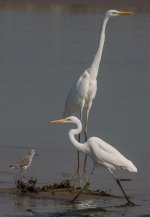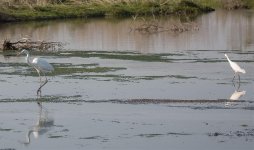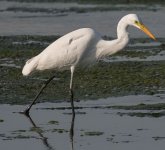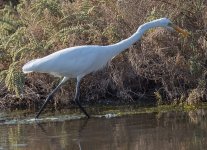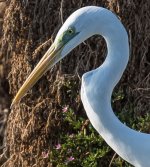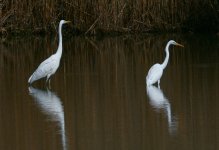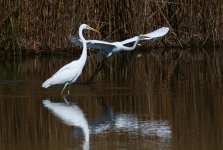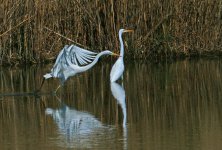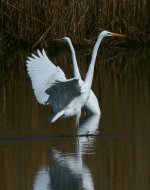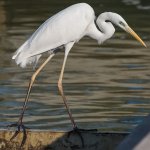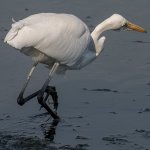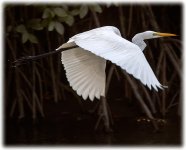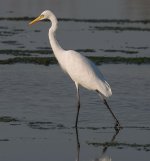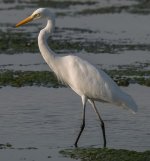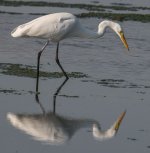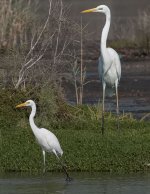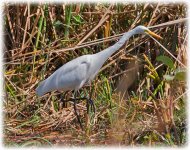Aladdin
Well-known member

Dear Members and Bird watchers
How to see the difference between a young and old Great Egret? For how long time do a Great Egret grow to be a "GREAT" Egret?
Picture #1 We see a Common Greenshank, but look at the size difference between the two Great Egrets. And I have no doubt that the "LITTLE" Egret is a Great Egret, gape extends between the eye and it looks exactly the same as the big Egret in colours etc. Is this a young Great Egret?
Picture #2 A Great Egret and a smaller Egret. Great difference in size. IN picture # 3 and 4 we can see the smaller Egret, yellow bill and yellow gape extending just behind the eyes.
I think that they have only spotted one Intermediate Egret in Dubai. And I was thinking Cattle Egret even though it is not walking around in the pastures. I have seen them fishing before and I have thought it was a Little Egret before I realized that the bill was yellow.
But this small Egret is too big to be a Cattle Egret. And the hunting style, leaning forward with extended neck as the Intermediate Egret. Yellow bill and Iores. Gape extending just a notch behind the eye, so it should not be a Intermediate.
And might be my imagination, the head is more round than the Great Egret, comparing with picture #5.
Any Ideas about the identity of the bird in picture #2 and 3? Is it a small Great Egret?
Kind regards and happy birding
Aladdin
How to see the difference between a young and old Great Egret? For how long time do a Great Egret grow to be a "GREAT" Egret?
Picture #1 We see a Common Greenshank, but look at the size difference between the two Great Egrets. And I have no doubt that the "LITTLE" Egret is a Great Egret, gape extends between the eye and it looks exactly the same as the big Egret in colours etc. Is this a young Great Egret?
Picture #2 A Great Egret and a smaller Egret. Great difference in size. IN picture # 3 and 4 we can see the smaller Egret, yellow bill and yellow gape extending just behind the eyes.
I think that they have only spotted one Intermediate Egret in Dubai. And I was thinking Cattle Egret even though it is not walking around in the pastures. I have seen them fishing before and I have thought it was a Little Egret before I realized that the bill was yellow.
But this small Egret is too big to be a Cattle Egret. And the hunting style, leaning forward with extended neck as the Intermediate Egret. Yellow bill and Iores. Gape extending just a notch behind the eye, so it should not be a Intermediate.
And might be my imagination, the head is more round than the Great Egret, comparing with picture #5.
Any Ideas about the identity of the bird in picture #2 and 3? Is it a small Great Egret?
Kind regards and happy birding
Aladdin




